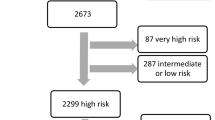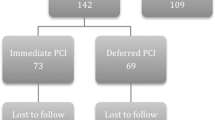Abstract
Historical data indicate that approximately 10% of acute coronary syndrome patients have no obstructive coronary artery disease (CAD) but contemporary incidence of non-obstructed coronary arteries in ST-segment elevation myocardial infarction (STEMI) is not clear. We aimed both to identify the contemporary incidence of MI without obstructive CAD (MINOCA)—using the ESC definition—and assess clinical outcomes. We assessed consecutive unselected STEMI patients presenting to the cardiac catheterisation laboratory with a view to undergoing primary percutaneous coronary intervention (PPCI). MINOCA was defined according to ESC criteria. Electronic patient records, blood results, angiographic and echocardiographic data were interrogated to determine final diagnosis, as well as 30-day and 1-year mortality rate. Of 2521 patients with full electronic dataset, 2158 (85.6%) underwent PPCI for obstructive CAD (angiographic stenosis > 70%). A further 167 (6.6%) with obstructive CAD were treated medically or surgically. The remaining 196 (7.8%) patients had absence of obstructive CAD at angiography, of whom 167 had no stenosis (< 30%) and 29 had mild coronary atheroma (stenosis > 30% but < 50%). A total of 110 (4.4%) patients met diagnostic criteria for MINOCA. All-cause mortality at 30-days and 1-year were 3.6% and 4.5%, respectively. In our cohort, 1 in 20 patients presenting with STEMI had MINOCA. This is the first description of the relatively high incidence of MINOCA in a STEMI cohort using current ESC definition and diagnostic criteria and could help power future trials in this area. Mortality rate was relatively high in our study and similar to that in large meta-analyses.


Similar content being viewed by others
References
DeWood MA, Spores J, Notske R et al (1980) Prevalence of total coronary occlusion during the early hours of transmural myocardial infarction. N Engl J Med 303:897–902
DeWood MA, Stifter WF, Simpson CS et al (1986) Coronary arteriographic findings soon after non-Q-wave myocardial infarction. N Engl J Med 315:417–423
Ibanez B, James S, Agewall S et al (2017) 2017 ESC Guidelines for the management of acute myocardial infarction in patients presenting with ST-segment elevation. Eur Heart J 39:119–177
Pasupathy S, Air T, Dreyer RP et al (2015) Systematic review of patients presenting with suspected myocardial infarction and nonobstructive coronary arteries. Circulation 131:861–870
Agewall S, Beltrame JF, Reynolds HR et al (2016) ESC working group position paper on myocardial infarction with non-obstructive coronary arteries. Eur Heart J 38:143–153. https://doi.org/10.1093/eurheartj/ehw149
Gehrie ER, Reynolds HR, Chen AY et al (2009) Characterization and outcomes of women and men with non–ST-segment elevation myocardial infarction and nonobstructive coronary artery disease: results from the Can Rapid Risk Stratification of Unstable Angina Patients Suppress Adverse Outcomes with Early. Am Heart J 158:688–694
Larsen AI, Galbraith PD, Ghali WA et al (2005) Characteristics and outcomes of patients with acute myocardial infarction and angiographically normal coronary arteries. Am J Cardiol 95:261–263
Lindahl B, Baron T, Erlinge D et al (2017) Medical therapy for secondary prevention and long-term outcome in patients with myocardial infarction with nonobstructive coronary artery disease clinical perspective. Circulation 135:1481–1489
Ghadri J-R, Wittstein IS, Prasad A et al (2018) International expert consensus document on Takotsubo syndrome (part I): clinical characteristics, diagnostic criteria, and pathophysiology. Eur Heart J 39:2032–2046
Thygesen K, Alpert JS, Jaffe AS et al (2018) Fourth universal definition of myocardial infarction. Eur Heart J 40:237–269. https://doi.org/10.1093/eurheartj/ehy462
Ghadri J-R, Wittstein IS, Prasad A et al (2018) International expert consensus document on Takotsubo syndrome (part II): diagnostic workup, outcome, and management. Eur Heart J 39:2047–2062
Prasad A, Dangas G, Srinivasan M et al (2014) Incidence and angiographic characteristics of patients With apical ballooning syndrome (takotsubo/stress cardiomyopathy) in the HORIZONS-AMI trial. Catheter Cardiovasc Interv 83:343–348
Widimsky P, Stellova B, Groch L et al (2006) Prevalence of normal coronary angiography in the acute phase of suspected ST-elevation myocardial infarction: experience from the PRAGUE studies. Can J Cardiol 22:1147–1152
Templin C, Ghadri JR, Diekmann J et al (2015) Clinical features and outcomes of Takotsubo (stress) cardiomyopathy. N Engl J Med 373:929–938
Ghadri JR, Kato K, Cammann VL et al (2018) Long-term prognosis of patients with Takotsubo syndrome. J Am Coll Cardiol 72:874–882
Hjort M, Lindahl B, Baron T, Jernberg T, Tornvall P, Eggers KM (2018) Prognosis in relation to high-sensitivity cardiac troponin T levels in patients with myocardial infarction and non-obstructive coronary arteries. Am Heart J 200:60–66
Bainey KR, Welsh RC, Alemayehu W, Westerhout CM, Traboulsi D, Anderson T, Brass N, Armstrong PW, Kaul P (2018) Population-level incidence and outcomes of myocardial infarction with non-obstructive coronary arteries (MINOCA): insights from the Alberta contemporary acute coronary syndrome patients invasive treatment strategies (COAPT) study. Int J Cardiol 264:12–17
Tornvall P, Collste O, Ehrenborg E et al (2016) A case-control study of risk markers and mortality in Takotsubo stress cardiomyopathy. J Am Coll Cardiol 67:1931–1936
Reynolds HR, Srichai MB, Iqbal SN et al (2011) Mechanisms of myocardial infarction in women without angiographically obstructive coronary artery disease. Circulation 124:1414–1425
Niccoli G, Scalone G, Crea F (2015) Acute myocardial infarction with no obstructive coronary atherosclerosis: mechanisms and management. Eur Heart J 36:475–481
Ong P, Athanasiadis A, Hill S et al (2008) Coronary artery spasm as a frequent cause of acute coronary syndrome. J Am Coll Cardiol 52:523–527
Beltrame JF, Crea F, Kaski JC et al (2015) International standardization of diagnostic criteria for vasospastic angina. Eur Heart J 38:ehv351
Montone RA, Niccoli G, Fracassi F et al (2017) Patients with acute myocardial infarction and non-obstructive coronary arteries: safety and prognostic relevance of invasive coronary provocative tests. Eur Heart J 39:91–98
Kaski JC (2018) Provocative tests for coronary artery spasm in MINOCA: necessary and safe? Eur Heart J 39:99–101
Author information
Authors and Affiliations
Corresponding author
Ethics declarations
Conflict of interest
The authors declare that there are no conflicts of interest to disclose.
Additional information
Publisher's Note
Springer Nature remains neutral with regard to jurisdictional claims in published maps and institutional affiliations.
Rights and permissions
About this article
Cite this article
Gue, Y.X., Corballis, N., Ryding, A. et al. MINOCA presenting with STEMI: incidence, aetiology and outcome in a contemporaneous cohort. J Thromb Thrombolysis 48, 533–538 (2019). https://doi.org/10.1007/s11239-019-01919-5
Published:
Issue Date:
DOI: https://doi.org/10.1007/s11239-019-01919-5




